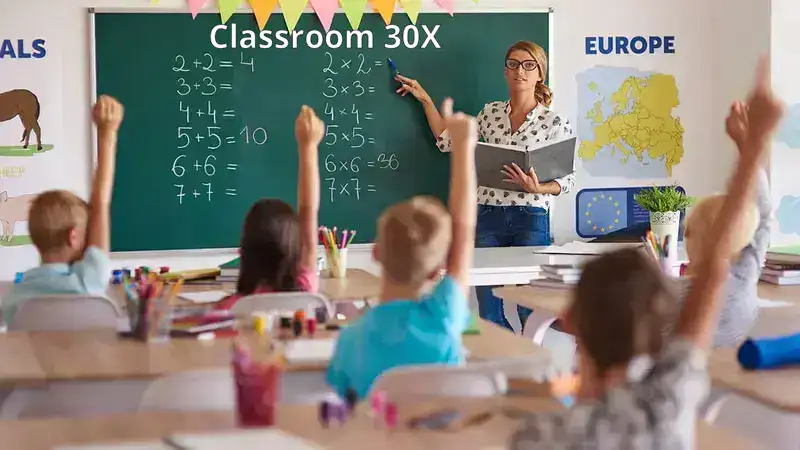In the modern era, education is evolving faster than ever. Traditional classrooms, once considered the gold standard, are now being challenged by innovative approaches that blend technology, pedagogy, and student engagement. One approach leading this transformation is classroom 30x. This model is revolutionizing the way students learn, teachers instruct, and schools operate.
In this comprehensive guide, we’ll explore classroom 30x in detail: what it is, why it matters, the benefits and challenges, how to implement it, and why it is poised to dominate the future of education.
What Is Classroom 30X?
Classroom 30x is not just a classroom—it’s an ecosystem designed to amplify learning outcomes up to thirty times compared to traditional methods. The “30x” symbolizes a multiplier effect: improved engagement, retention, collaboration, and student performance.
Key features include:
-
Technology Integration: AI, VR, AR, and cloud-based tools enhance interactivity.
-
Flexible Learning Spaces: Modular furniture and adaptive layouts support collaboration and personalized learning.
-
Data-Driven Teaching: Analytics help educators monitor progress, identify gaps, and optimize lessons.
Unlike static classroom 30x is dynamic, interactive, and designed for the needs of 21st-century learners.
Key Features of Classroom 30X
1. Personalized Learning Through AI
AI systems in classroom 30x track student progress and learning styles, providing tailored assignments and feedback. This ensures that every student can learn at their own pace, improving comprehension and reducing frustration.
2. Immersive Learning with VR & AR
VR and AR technologies allow students to explore content in 3D environments. Imagine walking through a historical site or conducting science experiments virtually—classroom 30x makes this possible.
3. Collaborative Digital Platforms
With classroom 30x, students can collaborate across devices and locations. Cloud-based tools facilitate group projects, discussions, and real-time feedback, encouraging teamwork and problem-solving skills.
4. Analytics & Data Insights
Teachers can track engagement, assignment completion, and learning gaps using dashboards. Classroom 30x ensures that instruction is data-informed, maximizing effectiveness.
Benefits of Classroom 30X
-
Boosted Student Engagement: Interactive lessons and immersive content keep students focused.
-
Enhanced Learning Outcomes: Personalized learning leads to better understanding and retention.
-
Future-Ready Skills: Students develop digital literacy, critical thinking, and collaboration skills.
-
Flexible Learning Environments: Hybrid, remote, and in-person learning are seamlessly supported.
By addressing diverse learning needs, classroom 30x transforms both teaching and learning experiences.
Challenges in Implementing Classroom 30X
While promising, implementing classroom 30x comes with challenges:
-
Infrastructure Costs: High-quality devices, VR headsets, and reliable internet are essential.
-
Teacher Training: Educators need continuous training to effectively use technology.
-
Equity & Accessibility: Ensuring all students have equal access to technology is crucial.
-
Data Privacy: Handling sensitive student data responsibly is a priority.
With proper planning, these challenges can be mitigated, making the transition smooth.
Step-by-Step Guide to Implement Classroom 30X
Step 1: Set Clear Objectives
Define the goals: Are you improving engagement, performance, or collaboration? Align your classroom design to these objectives.
Step 2: Pilot a Single Classroom
Start small. Convert one classroom into a classroom 30x environment, implement AI tools, flexible furniture, and collaboration platforms.
Step 3: Train Teachers
Offer workshops and ongoing support to help educators master new teaching tools and strategies.
Step 4: Integrate Technology Gradually
Introduce VR, AR, and AI in phases. Monitor student responses and adapt accordingly.
Step 5: Measure & Optimize
Use analytics to track engagement, performance, and satisfaction. Adjust the program based on insights.
Step 6: Scale Up
Once successful, expand classroom 30x to additional grades, subjects, or schools.
Future Trends in Classroom 30X
The future of classroom is bright. Emerging trends include:
-
AI Tutors and Assistants: Personalized guidance for each student.
-
Global Learning Networks: Connect students worldwide for cultural and collaborative learning.
-
Adaptive Learning Spaces: Classrooms that change layout and content based on student needs in real-time.
These trends ensure classroom 30x continues to evolve and stay ahead of traditional education models.
Why Classroom 30X Is a Game-Changer
Classroom doesn’t just improve education—it transforms it. By combining technology, flexibility, and data-driven teaching, schools can:
-
Maximize student engagement and performance.
-
Equip students with skills needed for the modern workforce.
-
Reduce teacher burnout through smarter tools and analytics.
-
Create a learning environment ready for hybrid, remote, or in-person education.
This holistic approach ensures that students not only learn better but are also prepared for the challenges of the future.
Conclusion
Classroom 30x represents the next evolution in education. It merges technology, personalized learning, and immersive experiences to create environments where students thrive. By adopting this model, educators can stay ahead of the curve, improving outcomes and engagement while preparing students for a rapidly changing world.
Click here for more information.
For schools looking to lead in modern education, embracing classroom is no longer optional—it’s essential.

